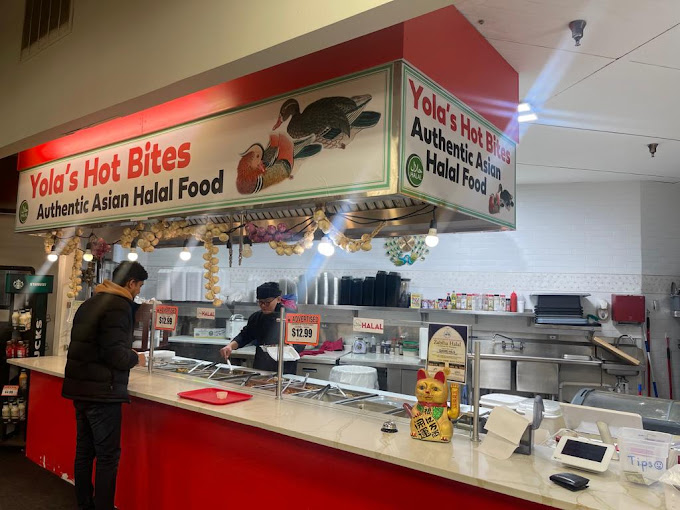Savor Genuine Eastern Food With a Pan-Asian Twist for a Culinary Journey
Starting a culinary journey with authentic Asian cuisine, improved with a Pan-Asian twist, offers an one-of-a-kind opportunity to explore the rich tapestry of flavors that define the region's varied culinary practices. This experience invites you to savor the exquisite balance of preferences-- wonderful, salty, spicy, and sour-- balanced by fragrant herbs and flavors. Envision the cutting-edge blend of Thai curry and ramen or the unforeseen joy of sushi burritos. As you ponder these luring meals, consider the cultural stories and historic impacts that form them, each bite supplying a tale waiting to be found.

Checking Out Pan-Asian Tastes
In the world of international gastronomy, Pan-Asian cuisine stands out for its impressive variety and the unified interaction of tastes from various Eastern cultures. This culinary technique celebrates the abundant customs and one-of-a-kind ingredients found across the continent, creating a tapestry of preferences that is both satisfying and interesting. Secret to Pan-Asian cuisine is its capability to balance contrasting tastes-- sweet, salted, spicy, and sour-- while highlighting the quality and high quality of each active ingredient.
From the umami-rich soy sauce of Japan to the intense chili peppers of Thailand, Pan-Asian cuisine supplies a substantial palette of tastes. These components are often incorporated in innovative means, improving recipes with layers of complexity. For circumstances, the use of fragrant natural herbs such as lemongrass and cilantro, common in Vietnamese and Thai cuisine, adds a revitalizing brightness to dishes, while the incorporation of coconut milk provides a luscious, abundant appearance.
The focus on fresh fruit and vegetables and aromatic spices ensures that each dish is not just a banquet for the taste but additionally for the senses. Pan-Asian food invites diners to begin on a culinary journey, discovering the substantial and varied landscapes of Asian gastronomy with every bite.
Fusion Dishes to Attempt
While Pan-Asian cuisine is commemorated for its traditional flavors, the modern-day cooking landscape is progressively welcoming fusion recipes that blend these classic components with influences from other regions. This cutting-edge approach not only honors the abundant heritage of Eastern cookeries but additionally presents novel preference experiences that appeal to modern palates.
A prime instance of such a combination meal is the Korean-Mexican taco, where marinated bulgogi beef is wrapped in a cozy tortilla, topped with kimchi and a hot gochujang-infused salsa. This mix marries the vibrant, savory tastes of Korea with the vibrant, fresh components of Mexican cuisine. Likewise, sushi burritos have actually gained popularity, integrating the fragile virtuosity of Japanese sushi with the hearty, hand-held convenience of a burrito, frequently including combination ingredients like tempura shrimp and avocado with a drizzle of wasabi mayo.
One more notable dish is Thai curry ramen, which infuses the creamy, aromatic flavors of Thai curry into the comforting broth of typical Japanese ramen, producing a harmonious mix that tantalizes the detects. These blend dishes prolong past mere uniqueness; they stand for a cooking discussion between cultures, motivating exploration and development on the planet of Pan-Asian food.
Necessary Components and Spices
To really value Pan-Asian cuisine, one have to recognize the important components and spices that develop its structure. This varied cooking design draws from an abundant tapestry of Oriental traditions, using an unified blend of tastes and appearances. Trick active ingredients include soy sauce, fish sauce, and oyster sauce, which impart a savory umami depth vital to Oriental dishes. Complementary to these are rice vinegar and mirin, offering a fragile acidity and sweet taste.
Aromatic elements are critical, with lemongrass, garlic, and ginger being common throughout various Pan-Asian dishes. These components provide an aromatic base that boosts the intricacy of tastes. Seasonings such as star anise, cardamom, and cinnamon introduce heat and personality, echoing impacts from areas like China and India.

Cooking Techniques and Tips
Grasping the art of Pan-Asian food requires experience with its unique cooking methods, each adding to the vibrant tapestry of tastes this culinary tradition is commemorated for. Central to these techniques is the stir-fry, a rapid cooking strategy that preserves the dietary integrity and vivid shades of active ingredients. Making use of a wok, the stir-fry technique allows for even warmth circulation, essential for accomplishing the characteristic structure and flavor equilibrium of Pan-Asian recipes.
One more basic method is steaming, specifically common in Chinese cuisine. This mild approach preserves the all-natural tastes and nutrients of ingredients, making it perfect for fish and shellfish and veggies. Dumplings, a beloved staple, usually gain from steaming, resulting in soft, succulent textures.
Grilling, additionally essential, imparts smoky midsts to dishes such as Oriental bulgogi or Japanese yakitori (Fine dining experience Islamabad). This technique typically includes marinading ingredients, allowing tastes to pass through deeply prior to food preparation over an open fire or warm plate
Lastly, mastering the art of stabilizing tastes-- sweet, sour, salted, bitter, and umami-- is essential. Appropriately layering these aspects can boost a dish from common to remarkable, using a complicated and pleasing cooking experience that embodies the significance of Pan-Asian cuisine.
Eating Experiences Worldwide
Around the world, Pan-Asian cuisine offers an unequaled eating experience, commemorated for its rich tapestry of flavors and dynamic presentations. This culinary sensation has gone beyond social limits, capturing the hearts and palates of food fanatics worldwide. In cosmopolitan cities fresh York, London, and Sydney, Pan-Asian restaurants offer as melting pots where cooking practices from Thailand, Japan, China, and beyond converge, supplying diners with a diverse mix of dishes that highlight the region's variety.
The worldwide appeal of Pan-Asian cuisine depends on its capability to use both credibility and development. Chefs skillfully wed conventional active ingredients such as lemongrass, soy sauce, and miso with contemporary strategies, causing meals that are both refreshingly new and acquainted. This blend allows diners to wikipedia reference get started on a culinary trip that appreciates heritage while accepting modernity.
In addition, eating experiences are boosted cafeteria near me via attentively designed settings that reflect the ethos of Pan-Asian visual appeals. From minimal Japanese-inspired insides to vivid Thai-themed areas, each restaurant offers a special setting that matches the culinary offerings. Consequently, clients are not merely eating a meal however partaking in a cultural experience, making Pan-Asian dining a really worldwide phenomenon.
Verdict
The expedition of Pan-Asian food uses an extensive understanding of the complex interaction of flavors and cooking customs across Asia. By welcoming blend meals such as Thai curry ramen and sushi burritos, the cooking trip not just highlights the flexibility of conventional ingredients but likewise showcases ingenious contemporary methods. This gastronomic journey, enriched by vital spices and cooking approaches, gives an unique chance to value the multiculturalism and culinary virtuosity that specify Pan-Asian cuisine on a worldwide range.
Embarking on a cooking trip with genuine Asian cuisine, enhanced with a Pan-Asian twist, uses a special opportunity to discover the abundant tapestry of flavors that define the region's varied culinary customs.In the world of global gastronomy, Pan-Asian food stands out for its exceptional diversity and the unified interplay of tastes from various Eastern cultures. Trick to Pan-Asian food is its ability to stabilize contrasting tastes-- sweet, salted, spicy, and sour-- while highlighting the quality and high quality of each ingredient.
